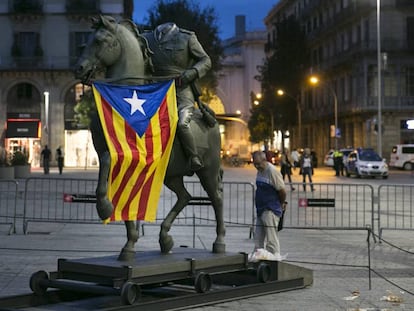Protesters topple Franco statue at controversial Barcelona exhibition
Presence of likeness of dictator had caused anger in independence-minded region of Spain

Protesters in Barcelona have knocked over a statue of former Spanish dictator General Francisco Franco, which served as the centerpiece for a highly controversial exhibition in the Catalan city examining his legacy.
The statue, an equestrian likeness of the military leader, has been the target of constant attacks since it appeared as part of the Franco, Victory, Republic and Impunity in Urban Spaces show, which opened on Monday at Barcelona’s Born Center for Culture and Memory (BCCM).
The statue was pelted with eggs and decorated with a pigs-head and a blow-up doll
Over the previous few days, people angry at the exhibition had pelted the statue, which had been positioned on the street in front of the BCCM, with eggs and rotting fruit. On one occasion it was crowned with a pig’s head, while others placed a blow-up doll atop it.
On Thursday evening, however, the statue was knocked to the ground by three youths who jumped the half-meter high fence protecting the sculpture and yanked at it until it collapsed to the ground.
Two municipal garbage trucks were needed to collect the pieces of the sculpture, which was only removed from Barcelona’s Montjuic Castle in 2001. It was later vandalized and its head knocked off.
The first truck carried off what remained of the body of Franco, who ruled the country for nearly 40 years. Several onlookers applauded when the figure was suspended in the air above a garbage truck, while one group of young people even popped the cork on a bottle of cava.
Remains of the horse were placed in a second truck and by 2am on Friday no traces remained of the sculpture.
Tres tipos derriban a #Franco d @BornCC pic.twitter.com/SJEfTOTvOa
— Alfonso Congostrina (@alfcongostrina) October 20, 2016
Three people topple #Franco
One of the youths responsible was later detained after security staff at the BCCM contacted police. He was later released, while police continue to investigate the incident using CCTV footage provided by the gallery.
“You could see it coming. What did they expect?” said the people who gathered in Born minutes after the incident, which came on a day during which opposition politicians in Barcelona had heavily criticized city Mayor Ada Colau and her team, who back the exhibition in Born.
It is not known whether the statue can be repaired so that it can retake its position outside the BCCM.
The removal of the statue is the latest chapter in the story of one of the most highly anticipated exhibitions in Barcelona in many years.
Just minutes after the statue was installed, it was pelted with eggs by 48-year-old Ernest Sant, an activist campaigning for independence for the northeastern region of Spain. He was not charged by police and later boasted that four of the eggs he threw had hit their mark. Later the equestrian likeness was attacked with rotting fruit and splattered with red and white paint, but authorities decided not to clean the statue.
The exhibition highlights the persistence of Franco-era symbols decades after his death
The opening of the exhibition, which is taking place at a venue once considered the ground zero of Catalonia’s independence movement, was marred by protests and even a fist fight while politicians with the pro-independence Republic Left of Catalonia (ERC) and Convergence and Union (CiU) parties boycotted the event.
The exhibition, which seems to have been misunderstood by many, includes press clippings, documents and photographs from different periods showing the persistence of symbols of the Franco era in Spain decades after the country’s return to democracy. It examines the impunity those symbols have enjoyed.
It is part of a larger dialogue in Spain about how the country should deal with its difficult past. Most statues of Franco were taken down a long time ago but controversy still rages over streets and buildings that retain names linked to the dictatorship. Forty years after the death of the dictator, there are still streets named after generals who led the military uprising.
In 2007, the Socialist government of former Prime Minister José Luis Rodríguez Zapatero passed the Historical Memory Law, granting subsidies to projects such as the opening of mass graves from the Civil War.
It also took into account the removal of statues and the changing of place names connected to the Franco regime. But funding was slashed when the conservative Popular Party (PP) arrived in power in 2011, halting such projects throughout Spain.
The last statue of Franco in mainland Spain, in the northern city of Santander, was not removed until 2008.
English version by George Mills.
Tu suscripción se está usando en otro dispositivo
¿Quieres añadir otro usuario a tu suscripción?
Si continúas leyendo en este dispositivo, no se podrá leer en el otro.
FlechaTu suscripción se está usando en otro dispositivo y solo puedes acceder a EL PAÍS desde un dispositivo a la vez.
Si quieres compartir tu cuenta, cambia tu suscripción a la modalidad Premium, así podrás añadir otro usuario. Cada uno accederá con su propia cuenta de email, lo que os permitirá personalizar vuestra experiencia en EL PAÍS.
¿Tienes una suscripción de empresa? Accede aquí para contratar más cuentas.
En el caso de no saber quién está usando tu cuenta, te recomendamos cambiar tu contraseña aquí.
Si decides continuar compartiendo tu cuenta, este mensaje se mostrará en tu dispositivo y en el de la otra persona que está usando tu cuenta de forma indefinida, afectando a tu experiencia de lectura. Puedes consultar aquí los términos y condiciones de la suscripción digital.
More information
Últimas noticias
Most viewed
- Alain Aspect, Nobel laureate in physics: ‘Einstein was so smart that he would have had to recognize quantum entanglement’
- Maps of the US attack on Venezuela: Targets, airspace and deployed fleet
- Key points of the military attack on Venezuela: Early morning bombings and a ‘captured’ president
- David King, chemist: ‘There are scientists studying how to cool the planet; nobody should stop these experiments from happening’
- Oil, gold and rare earth elements: the backdrop to US political tension with Venezuela











































